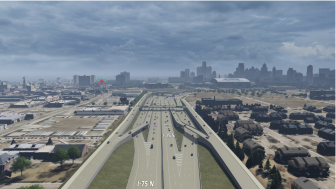
The I-375 Reconnecting Communities project acknowledges the 1960s construction that destroyed Detroit’s Black Bottom neighborhood. Image: Michigan Department of Transportation
By Sophia Brandt
LANSING – With reconstruction planned for Detroit’s I-375, other Michigan highways with a similar past of dividing Black communities are being looked at as state road officials consider ways to remedy historic mistakes.
I-375 will be reconstructed to become a boulevard, allowing for safer crossings and reconnecting the neighborhood after division caused by construction in the 1960s.
Flint I-475 may also be a contender for a similar rebuilding project, said Jeff Cranson, the director of communications for the Michigan Department of Transportation (MDOT).
Currently, I-475 is under study for rebuilding the road and bridges along the Bristol Road to Carpenter Road corridor, according to MDOT.
An MDOT study says reconstruction of I-475 may start in 2024, with the final segment expected to be open by fall of 2028.
This project differs from I-375 because it does not yet acknowledge how past highway construction tore neighborhoods apart.
“It might be a candidate for some component of this or something similar at some point,” Cranson said.
I-475 in Flint was built in the 1970s, according to the University of Michigan’s FLASH project, which looked through Flint’s past.
When the roadway was built, the St. John and Floral Park neighborhoods were destroyed.
Both were prominent Black neighborhoods, according to the FLASH project.
According to the project, homes in those neighborhoods were demolished to make space for I-475, similar to what happened for construction of I-375 in Detroit.
Displacement of Black communities by highways is a nationwide problem.
Construction of I-81 in Syracuse, New York, pushed more than 1,000 residents from their homes in the 1960s, according to Congress for the New Urbanism, a nonprofit organization in Washington, D.C.
That highway is now being replaced by a boulevard, similar to what is planned for I-375.
The construction of roads like I-375 and I-475 in Flint displaced communities and businesses. They often make travel harder for people in surrounding neighborhoods.
“In the era when I-375 was built, it definitely called for the destruction of some homes and businesses,” Cranson said.
The highways also reduced safety for walkers, bikers and users of other nonmotorized transportation.
The hope is that turning I-375 into a boulevard will calm traffic and allow residents and visitors to safely cross and to make the neighborhood more connected and accessible, according to MDOT.
Cranson said I-375 is the first project like it in Michigan but may influence future projects.
“I think there will be inspiration in terms of innovative thinking. It will spark new thinking about what can be done when a bridge or a freeway needs to be rebuilt. It’ll make people stop and think, ‘maybe this is something we could look at differently,’” he said.
In response to a history of redlining, a discriminatory housing practice, and community displacement, Detroit I-375 will become a boulevard under the plan.
“This goes back at least 10 years,” Cranson said. “Several bridges on that corridor were going to need to be replaced, and it kind of led to an epiphany of what else could be done with that corridor.”
Cranson said, “A lot of business leaders and city officials around the country thought having freeways through your downtown was progress, and they didn’t think of the consequences of cutting off or displacing communities, largely minority communities.”
Turning the freeway into a normal road will be a long process involving massive construction, with work on I-375 starting in 2025, ending in 2027 and with an estimated $300 million price tag, according to MDOT.
A federal grant from the Infrastructure Investment and Jobs Act will cover about one-third of the cost, MDOT said.
The freeway will need to be lowered to sit even with the land.
Brad Wieferich, the acting director of MDOT, said, “It’s a pretty complex project, but the difficult part of this project is figuring out how to be most effective at addressing the historical and cultural issues and figuring out what the best use for that excess property is going to be.”
“Certainly there will be some inconvenience during construction, noise and disruptions. But I know city officials and MDOT officials are going to work to keep them engaged and communicate every step of the way,” Cranson said.
“Just like any construction project, there’s certainly trepidation at first, but people are always patient when they know the outcome is going to be something better,” he said.
Wieferich said, “It’s going to free up a lot of land, so we’re going to be working closely with the community to decide what the best use for that is.”
The project will also develop signs and other ways to memorialize the history of I-375.
“We do know in some way, shape or form we want to acknowledge the past and what happened there,” Wieferich said. “There’s nothing that MDOT or the city or anyone could do that would correct the past, but we do want to acknowledge and address it.”
Sophia Brandt reports for Capital News Service